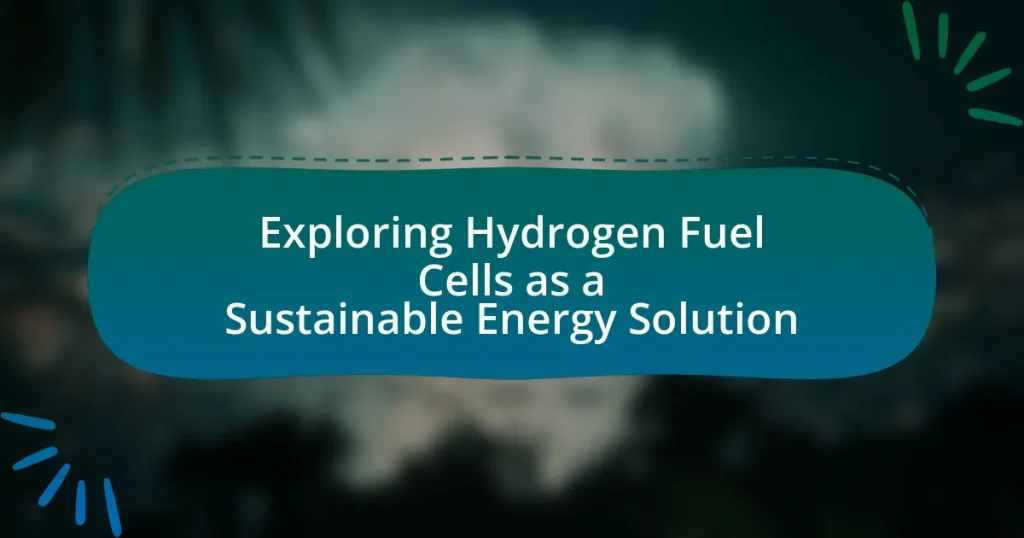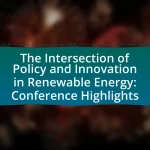Hydrogen fuel cells are electrochemical devices that convert hydrogen and oxygen into electricity, producing only water and heat as byproducts. This article explores the operation, components, and types of hydrogen fuel cells, highlighting their efficiency and environmental benefits. It discusses the role of hydrogen fuel cells in sustainable energy systems, their advantages over traditional energy solutions, and the challenges to their widespread adoption. Additionally, the article examines advancements in technology, economic benefits, and the future prospects for hydrogen fuel cells as a key player in the transition to clean energy.
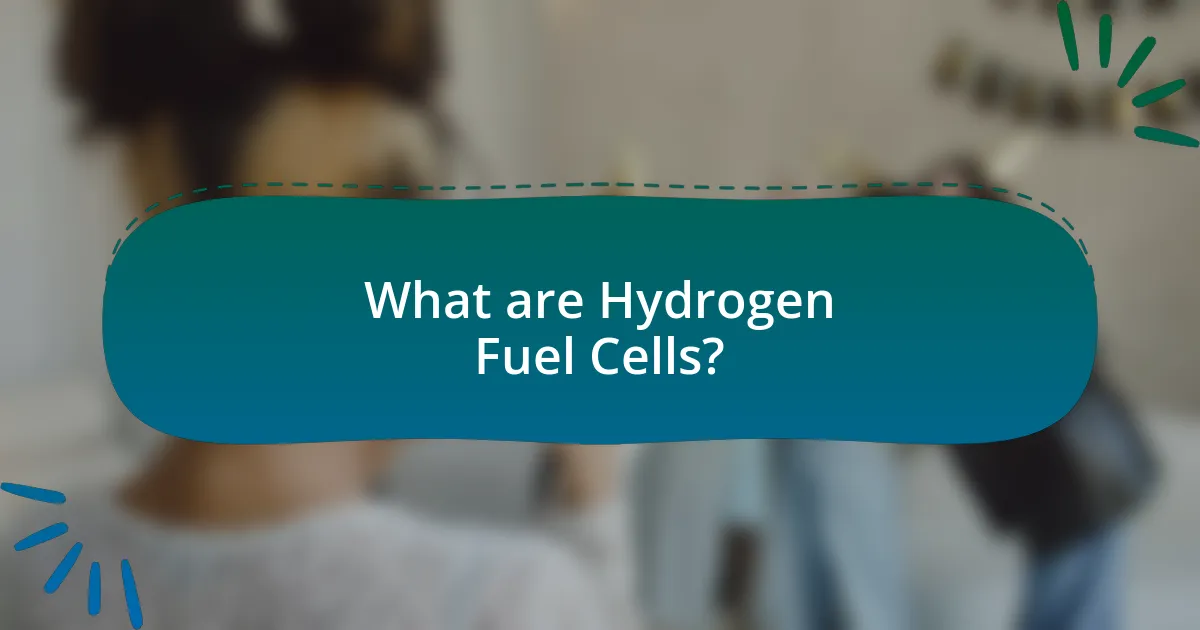
What are Hydrogen Fuel Cells?
Hydrogen fuel cells are electrochemical devices that convert hydrogen and oxygen into electricity, with water and heat as the only byproducts. This process occurs through a chemical reaction facilitated by an electrolyte, which allows protons to pass while electrons are directed through an external circuit, generating electric power. Hydrogen fuel cells are recognized for their efficiency and low environmental impact, as they produce zero emissions at the point of use. According to the U.S. Department of Energy, hydrogen fuel cells can achieve efficiencies of up to 60%, significantly higher than traditional combustion engines.
How do Hydrogen Fuel Cells operate?
Hydrogen fuel cells operate by converting chemical energy from hydrogen and oxygen into electrical energy through an electrochemical reaction. In this process, hydrogen gas is fed into the anode side of the fuel cell, where it splits into protons and electrons. The protons pass through a proton exchange membrane to the cathode side, while the electrons travel through an external circuit, generating electricity. At the cathode, oxygen from the air combines with the protons and electrons to produce water and heat as byproducts. This mechanism allows hydrogen fuel cells to generate clean energy, emitting only water vapor, which supports their role as a sustainable energy solution.
What are the key components of a Hydrogen Fuel Cell?
The key components of a hydrogen fuel cell are the anode, cathode, electrolyte, and external circuit. The anode is where hydrogen gas is supplied and split into protons and electrons. The electrolyte allows only protons to pass through while blocking electrons, which travel through the external circuit to generate electricity. The cathode is where oxygen is introduced, and it combines with the protons and electrons to produce water and heat as byproducts. These components work together to convert chemical energy from hydrogen into electrical energy efficiently, making hydrogen fuel cells a viable option for sustainable energy solutions.
How does the electrochemical process work in Hydrogen Fuel Cells?
The electrochemical process in hydrogen fuel cells involves the conversion of chemical energy from hydrogen and oxygen into electrical energy through an electrochemical reaction. In this process, hydrogen gas is supplied to the anode, where it is split into protons and electrons by a catalyst. The protons pass through the electrolyte membrane to the cathode, while the electrons travel through an external circuit, generating electricity. At the cathode, oxygen from the air combines with the protons and electrons to form water, which is the only byproduct of this reaction. This efficient conversion process typically operates at around 60% to 80% efficiency, making hydrogen fuel cells a promising technology for sustainable energy solutions.
What types of Hydrogen Fuel Cells exist?
There are several types of hydrogen fuel cells, including Proton Exchange Membrane Fuel Cells (PEMFC), Solid Oxide Fuel Cells (SOFC), Alkaline Fuel Cells (AFC), Phosphoric Acid Fuel Cells (PAFC), and Direct Methanol Fuel Cells (DMFC). Each type operates on different principles and materials, which affects their efficiency, temperature range, and applications. For instance, PEMFCs are widely used in transportation due to their quick start-up time and low operating temperature, while SOFCs are more suitable for stationary power generation because they operate at high temperatures and have higher efficiency.
What distinguishes Proton Exchange Membrane Fuel Cells from other types?
Proton Exchange Membrane Fuel Cells (PEMFCs) are distinguished from other types of fuel cells primarily by their use of a solid polymer membrane as the electrolyte, which allows for efficient proton conduction while being impermeable to gases. This design enables PEMFCs to operate at lower temperatures (typically between 60 to 80 degrees Celsius) compared to high-temperature fuel cells, such as Solid Oxide Fuel Cells (SOFCs), which operate at temperatures exceeding 600 degrees Celsius. Additionally, PEMFCs have a rapid start-up time and can respond quickly to changes in power demand, making them suitable for applications like vehicles and portable power systems. Their efficiency in converting hydrogen to electricity, often exceeding 50%, further sets them apart from other fuel cell technologies.
How do Solid Oxide Fuel Cells function differently?
Solid Oxide Fuel Cells (SOFCs) function differently by utilizing a solid electrolyte to conduct ions, specifically oxygen ions, from the cathode to the anode, where they react with hydrogen to produce electricity, water, and heat. This mechanism allows SOFCs to operate at high temperatures, typically between 600 to 1,000 degrees Celsius, which enhances their efficiency and enables the use of a variety of fuels, including natural gas and biogas. The high operating temperature also facilitates internal reforming of hydrocarbons, reducing the need for external fuel processing.
What are the advantages of using Hydrogen Fuel Cells?
Hydrogen fuel cells offer several advantages, including high efficiency, zero emissions, and quick refueling times. High efficiency is demonstrated by their ability to convert chemical energy directly into electrical energy with efficiencies exceeding 60%, compared to traditional combustion engines which typically operate at around 20-30% efficiency. Zero emissions are a significant benefit, as the only byproduct of hydrogen fuel cells is water vapor, making them environmentally friendly. Additionally, hydrogen fuel cells can be refueled in just a few minutes, similar to gasoline vehicles, which enhances their practicality for consumers. These advantages position hydrogen fuel cells as a promising solution in the transition to sustainable energy systems.
How do Hydrogen Fuel Cells contribute to reducing greenhouse gas emissions?
Hydrogen fuel cells contribute to reducing greenhouse gas emissions by converting hydrogen and oxygen into electricity, with water vapor as the only byproduct. This process eliminates carbon dioxide and other harmful emissions typically associated with fossil fuel combustion. According to the U.S. Department of Energy, hydrogen fuel cells can achieve efficiencies of up to 60%, significantly reducing the overall carbon footprint compared to traditional energy sources. Additionally, when hydrogen is produced from renewable sources, such as wind or solar power, the entire lifecycle emissions are minimized, further enhancing their role in combating climate change.
What economic benefits do Hydrogen Fuel Cells provide?
Hydrogen fuel cells provide significant economic benefits, including job creation, energy independence, and reduced operational costs. The hydrogen fuel cell industry is projected to create over 1 million jobs by 2030, driven by the demand for clean energy technologies. Additionally, hydrogen fuel cells can enhance energy independence by reducing reliance on imported fossil fuels, which can stabilize local economies. Furthermore, hydrogen fuel cells have lower operational costs compared to traditional fossil fuel systems, as they can utilize renewable energy sources for hydrogen production, leading to long-term savings. These benefits are supported by reports from the Hydrogen Council, which indicate that the hydrogen economy could contribute $2.5 trillion to the global economy by 2050.
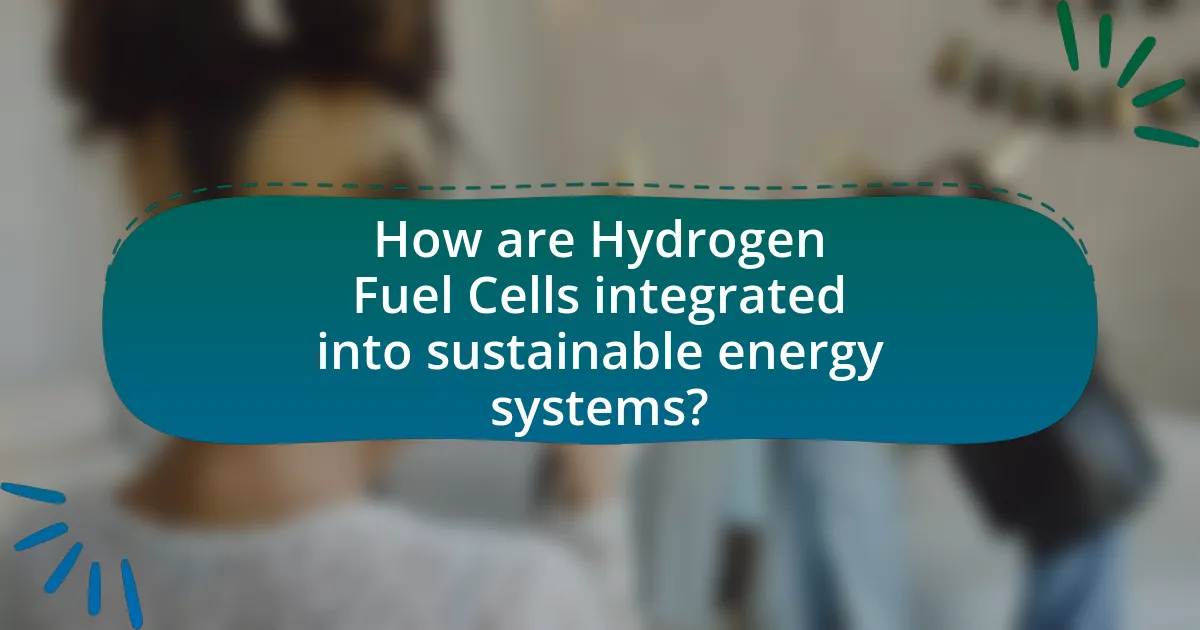
How are Hydrogen Fuel Cells integrated into sustainable energy systems?
Hydrogen fuel cells are integrated into sustainable energy systems by converting hydrogen into electricity through an electrochemical reaction, producing only water as a byproduct. This integration supports renewable energy sources, such as solar and wind, by providing a means to store excess energy and convert it back into electricity when needed, thus enhancing grid stability. For instance, the International Energy Agency reports that hydrogen can be produced from renewable sources, making it a clean energy carrier that complements intermittent renewable generation. Additionally, hydrogen fuel cells are utilized in various applications, including transportation and stationary power generation, contributing to reduced greenhouse gas emissions and promoting energy diversification.
What role do Hydrogen Fuel Cells play in renewable energy integration?
Hydrogen fuel cells play a crucial role in renewable energy integration by providing a means to store and convert excess renewable energy into usable power. They facilitate the balancing of supply and demand in energy systems, particularly when renewable sources like solar and wind generate more energy than is immediately needed. For instance, during peak production times, excess energy can be used to produce hydrogen through electrolysis, which can then be stored and converted back into electricity when demand rises or renewable generation decreases. This capability enhances grid stability and supports the transition to a low-carbon energy system, as evidenced by projects like the Hydrogen Energy Supply Chain in Australia, which demonstrates the viability of hydrogen as a flexible energy carrier.
How can Hydrogen Fuel Cells store excess energy from renewable sources?
Hydrogen fuel cells can store excess energy from renewable sources by converting that energy into hydrogen through a process called electrolysis. During electrolysis, electricity generated from renewable sources, such as solar or wind, splits water into hydrogen and oxygen. The produced hydrogen can then be stored and later used in fuel cells to generate electricity when needed. This method effectively captures and utilizes surplus energy, addressing the intermittency of renewable energy sources. For instance, the International Energy Agency reports that hydrogen production via electrolysis can provide a flexible energy storage solution, enabling the integration of higher shares of renewables into the energy system.
What are the challenges of integrating Hydrogen Fuel Cells into existing energy grids?
Integrating hydrogen fuel cells into existing energy grids presents several challenges, including infrastructure compatibility, cost, and regulatory hurdles. Infrastructure compatibility issues arise because current energy grids are primarily designed for conventional energy sources, necessitating significant modifications to accommodate hydrogen fuel cells. The cost challenge is evident in the high initial investment required for hydrogen production, storage, and distribution systems, which can deter widespread adoption. Additionally, regulatory hurdles exist as existing policies may not support the integration of hydrogen technologies, requiring new frameworks to ensure safety and efficiency. These challenges must be addressed to facilitate the successful incorporation of hydrogen fuel cells into energy systems.
How do Hydrogen Fuel Cells compare to other energy solutions?
Hydrogen fuel cells offer a clean energy solution that produces only water as a byproduct, distinguishing them from fossil fuels, which emit greenhouse gases. Compared to battery electric systems, hydrogen fuel cells can provide longer ranges and faster refueling times, making them suitable for heavy-duty applications like trucks and buses. Additionally, hydrogen fuel cells have a higher energy density than batteries, allowing for more efficient energy storage and transport. According to the U.S. Department of Energy, hydrogen fuel cells can achieve efficiencies of up to 60% in converting hydrogen to electricity, surpassing the typical efficiency of internal combustion engines, which is around 20-30%. This efficiency, combined with the potential for renewable hydrogen production through electrolysis, positions hydrogen fuel cells as a competitive alternative in the transition to sustainable energy solutions.
What are the differences between Hydrogen Fuel Cells and battery electric vehicles?
Hydrogen fuel cells and battery electric vehicles (BEVs) differ primarily in their energy storage and conversion methods. Hydrogen fuel cells generate electricity through a chemical reaction between hydrogen and oxygen, producing water as a byproduct, while BEVs store electricity in batteries and use it to power electric motors directly.
Hydrogen fuel cells typically offer faster refueling times, often under five minutes, and can provide longer driving ranges compared to many BEVs, which may require several hours to recharge and have limited ranges depending on battery capacity. Additionally, hydrogen fuel cells can be more efficient in certain applications, particularly in heavy-duty transport, where weight and range are critical factors. In contrast, BEVs benefit from a more established charging infrastructure and lower operational costs due to fewer moving parts and less maintenance.
The U.S. Department of Energy states that hydrogen fuel cells can achieve efficiencies of up to 60% in converting fuel to electricity, while BEVs can reach efficiencies of around 80-90% from grid to wheel. This efficiency difference highlights the distinct operational characteristics and potential applications of each technology.
How do Hydrogen Fuel Cells stack up against traditional fossil fuels?
Hydrogen fuel cells offer a cleaner alternative to traditional fossil fuels by producing electricity through a chemical reaction between hydrogen and oxygen, emitting only water vapor as a byproduct. In contrast, fossil fuels release carbon dioxide and other pollutants when burned, contributing to climate change and air quality issues. According to the U.S. Department of Energy, hydrogen fuel cells can achieve efficiencies of up to 60%, while conventional fossil fuel power plants typically operate at around 33% efficiency. This efficiency, combined with the potential for hydrogen production from renewable sources, positions hydrogen fuel cells as a more sustainable energy solution compared to fossil fuels.
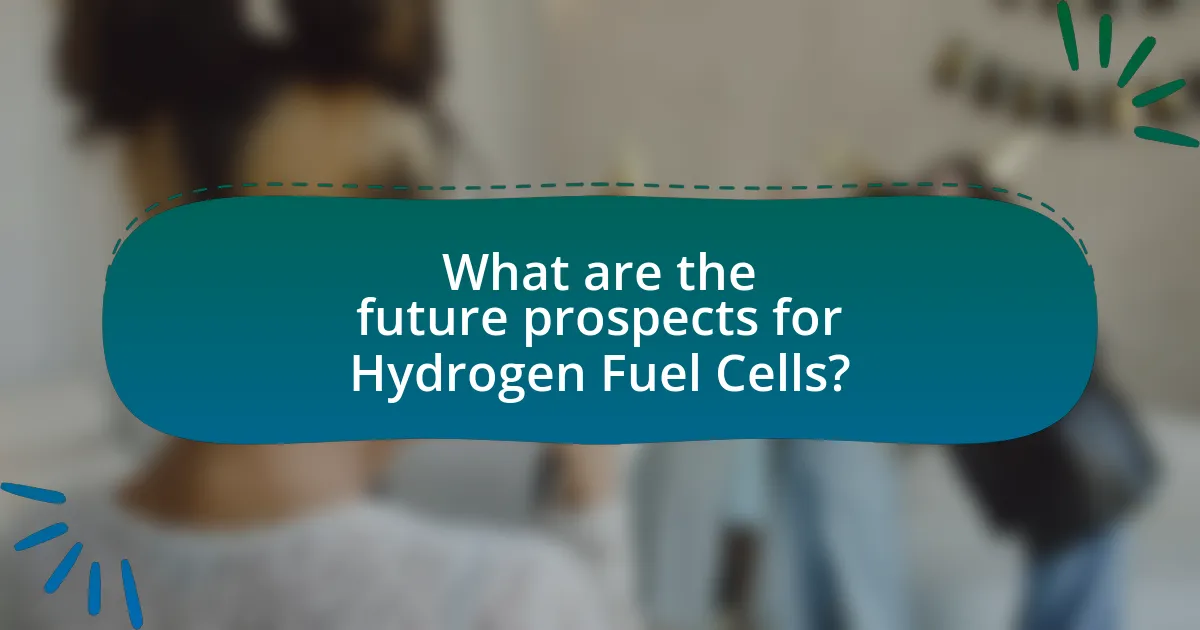
What are the future prospects for Hydrogen Fuel Cells?
The future prospects for hydrogen fuel cells are promising, driven by advancements in technology and increasing demand for clean energy solutions. Hydrogen fuel cells are expected to play a significant role in decarbonizing various sectors, including transportation, industrial processes, and power generation. According to the International Energy Agency, the global hydrogen demand could reach 500 million tons by 2050, with fuel cells being a key technology in achieving this growth. Additionally, investments in hydrogen infrastructure and research are projected to exceed $300 billion by 2030, further supporting the expansion of hydrogen fuel cell applications.
What advancements are being made in Hydrogen Fuel Cell technology?
Recent advancements in hydrogen fuel cell technology include improvements in efficiency, cost reduction, and durability. Researchers have developed new catalysts that significantly enhance the electrochemical reactions within fuel cells, leading to higher energy output while using less precious metals like platinum. For instance, a study published in the journal Nature Energy in 2021 demonstrated a novel catalyst that increased fuel cell efficiency by 30%. Additionally, advancements in membrane technology, such as the development of proton exchange membranes that operate at higher temperatures, have improved the overall performance and lifespan of fuel cells. Furthermore, companies are investing in scalable production methods, which have reduced the cost of hydrogen production and fuel cell systems by up to 50% over the past five years, making them more competitive with traditional energy sources.
How is research improving the efficiency of Hydrogen Fuel Cells?
Research is improving the efficiency of hydrogen fuel cells by developing advanced catalysts and optimizing membrane materials. For instance, recent studies have shown that using platinum alloys as catalysts can significantly reduce the amount of platinum needed while maintaining high performance, thus lowering costs and enhancing efficiency. Additionally, innovations in proton exchange membranes, such as those made from Nafion and other advanced polymers, have demonstrated improved conductivity and durability, which directly contribute to higher energy output and longer operational life. These advancements are supported by research published in journals like the Journal of Power Sources, where findings indicate that these materials can enhance fuel cell performance by up to 30%.
What innovations are emerging in Hydrogen production methods?
Innovations in hydrogen production methods include advancements in electrolysis, particularly proton exchange membrane (PEM) electrolysis, which offers higher efficiency and faster response times compared to traditional alkaline electrolysis. Additionally, researchers are developing photoelectrochemical (PEC) water splitting, utilizing solar energy to directly produce hydrogen, which can significantly reduce costs and carbon emissions. Furthermore, biotechnological approaches, such as using microorganisms for biological hydrogen production, are gaining traction, showcasing the potential for sustainable and renewable hydrogen sources. These innovations are supported by studies indicating that PEM electrolysis can achieve efficiencies exceeding 80%, while PEC systems are being optimized to enhance their solar-to-hydrogen conversion rates.
What are the barriers to widespread adoption of Hydrogen Fuel Cells?
The barriers to widespread adoption of hydrogen fuel cells include high production costs, limited infrastructure, and safety concerns. High production costs stem from the current methods of hydrogen generation, primarily through natural gas reforming, which is expensive and emits carbon dioxide. Limited infrastructure is evident in the scarcity of hydrogen refueling stations, which hinders the practicality of hydrogen fuel cell vehicles. Safety concerns arise from the flammability of hydrogen and the need for stringent regulations to ensure safe handling and storage. These factors collectively impede the transition to hydrogen fuel cells as a mainstream energy solution.
How do infrastructure challenges impact the growth of Hydrogen Fuel Cells?
Infrastructure challenges significantly hinder the growth of hydrogen fuel cells by limiting the availability of refueling stations and distribution networks. The lack of a comprehensive hydrogen infrastructure restricts consumer adoption and investment in hydrogen technologies, as potential users face difficulties in accessing fuel. For instance, as of 2023, there are only about 50 hydrogen refueling stations in the United States, compared to thousands of electric vehicle charging stations, which illustrates the disparity in infrastructure development. This limited infrastructure not only affects the operational feasibility of hydrogen fuel cell vehicles but also deters manufacturers from producing more models, thereby stalling market growth.
What regulatory hurdles must be overcome for Hydrogen Fuel Cells to thrive?
Hydrogen fuel cells must overcome several regulatory hurdles to thrive, including safety standards, infrastructure development, and environmental regulations. Safety standards are critical as hydrogen is highly flammable, necessitating stringent guidelines for storage, transport, and usage to prevent accidents. Infrastructure development is essential for creating a network of hydrogen refueling stations, which requires regulatory support for funding and permitting processes. Environmental regulations must also be addressed to ensure that hydrogen production methods, particularly those involving fossil fuels, comply with emissions standards. These hurdles are significant, as evidenced by the International Energy Agency’s report indicating that regulatory frameworks significantly influence the deployment of hydrogen technologies.
What practical steps can be taken to promote Hydrogen Fuel Cell adoption?
To promote Hydrogen Fuel Cell adoption, governments and industries should invest in infrastructure development, such as hydrogen refueling stations, to ensure accessibility for consumers. Research indicates that increasing the number of refueling stations can significantly enhance consumer confidence and usage rates, as seen in regions like California, where a network of over 50 stations supports a growing fleet of hydrogen vehicles. Additionally, providing financial incentives, such as tax credits or subsidies for hydrogen fuel cell vehicles, can stimulate market demand and lower the initial cost barrier for consumers. Studies show that financial incentives can lead to a 30% increase in adoption rates in emerging markets. Furthermore, fostering partnerships between public and private sectors can accelerate research and development efforts, leading to technological advancements that improve fuel cell efficiency and reduce production costs.
How can policymakers support the development of Hydrogen Fuel Cell technology?
Policymakers can support the development of Hydrogen Fuel Cell technology by implementing financial incentives and regulatory frameworks that promote research, development, and deployment. For instance, governments can provide grants and subsidies to companies engaged in hydrogen technology innovation, which can accelerate advancements and reduce costs. Additionally, establishing clear regulations and standards for hydrogen production, storage, and distribution can create a stable market environment, encouraging private investment. Evidence from countries like Germany, which has invested over €9 billion in hydrogen initiatives, demonstrates that such support can lead to significant advancements in technology and infrastructure, ultimately fostering a sustainable energy solution.
What role can consumers play in advancing Hydrogen Fuel Cell solutions?
Consumers can significantly advance Hydrogen Fuel Cell solutions by increasing demand for hydrogen-powered vehicles and supporting infrastructure development. By choosing hydrogen fuel cell vehicles over traditional gasoline or diesel options, consumers drive manufacturers to invest in research and production, leading to technological advancements and cost reductions. For instance, the global market for hydrogen fuel cell vehicles is projected to grow from 20,000 units in 2020 to over 2 million units by 2030, indicating a strong consumer influence on market dynamics. Additionally, consumers can advocate for policies that promote hydrogen infrastructure, such as refueling stations, which are essential for widespread adoption. This collective consumer action not only fosters innovation but also contributes to a sustainable energy transition, aligning with global climate goals.
